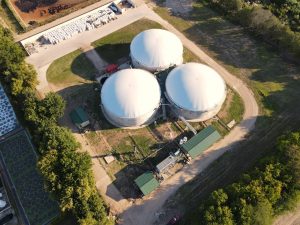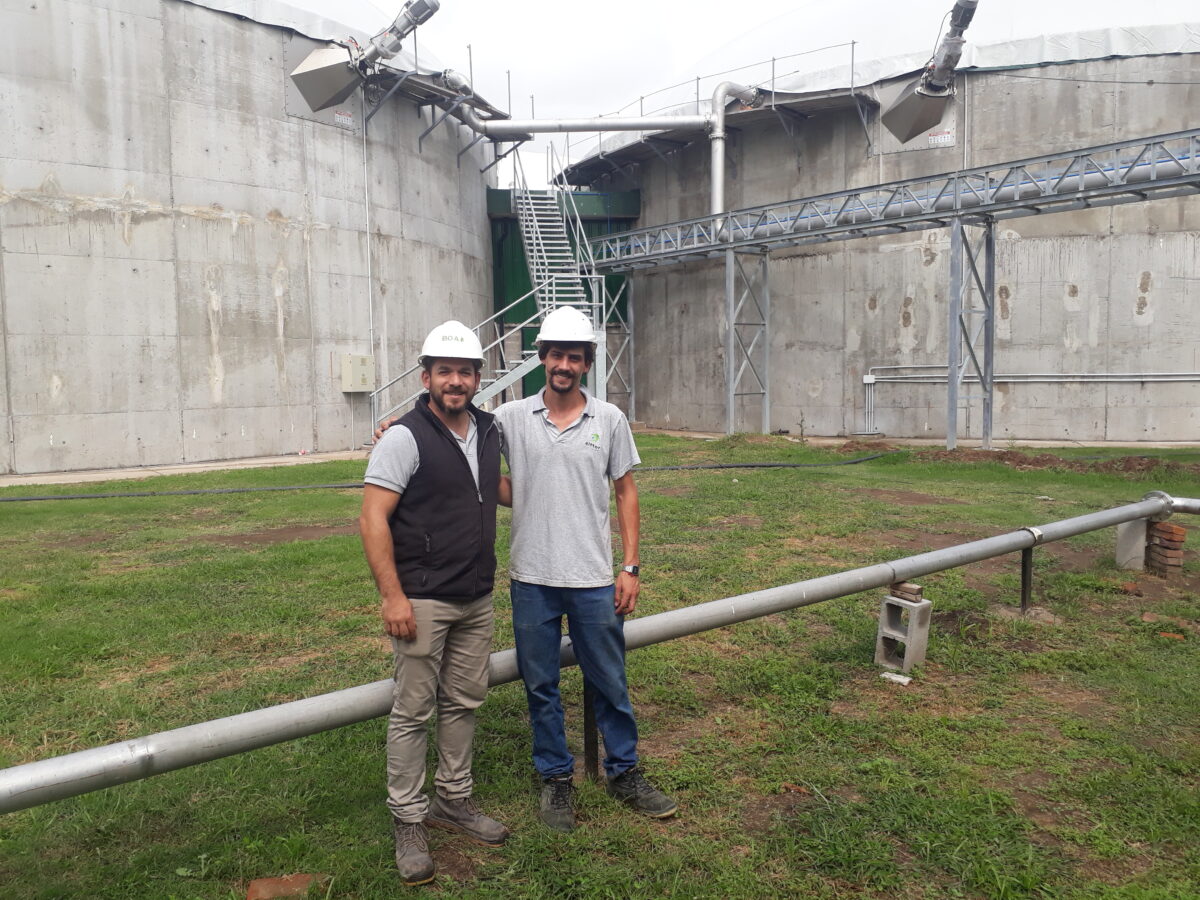Turning Agro-industrial Waste into Energy in Argentina
 31 Maret 2022
31 Maret 2022

Aerial view of the biogas plant located in the industrial park of Zárate, a municipality in eastern Argentina, featuring three large biodigesters. CREDIT: Courtesy of BGA Energía Sustentable
By Daniel Gutman
ZÁRATE, Argentina , Mar 31 2022 (IPS)
Three giant concrete cylinders with inflated membrane roofs are a strange sight in the industrial park of Zárate, a world of factories 90 kilometers from Buenos Aires that heavy trucks drive in and out of all day long. They are the heart of a plant that is about to start producing energy from agro-industrial waste, for the first time in Argentina.
“This is the first plant that will generate biogas with waste from the food industry. For example, fats from dairy companies or leftovers from meat processing plants where beef, chicken and pork are processed,” Ezequiel Weibel, one of the partners in the company that designed and executed the project, tells IPS.
“Until now, in this country we were used to biogas production using livestock effluents or crop residues, but not other kinds of organic waste,” adds Weibel, as he walks around the site and points to the sector where dozens of gigantic bags of pig blood meal are stockpiled.
Weibel is a young agricultural engineer who in 2011 created the company BGA Energía Sustentable together with his fellow student Martín Pinos, with the support of IncUBAgro.
IncUBAgro is a program of the School of Agronomy at the University of Buenos Aires (UBA), which encourages innovative projects aimed at solving agricultural, environmental and productive problems.
The plant’s three biodigesters have a capacity of 12,000 cubic meters and are set up to receive some 146 wet and 35 dry tons of waste per day from the eastern province of Buenos Aires. In the huge tanks the waste will be stored without oxygen so that the bacteria can do their work.
The organic matter will undergo an accelerated decomposition process, which will convert it into biogas, composed of 60 percent methane and 40 percent carbon dioxide.
The biogas, in turn, will be fed to a generator that will produce electricity and inject it into the national power grid, which will distribute it throughout the country. The plant, which has an installed capacity of 1.5 megawatts (MW), is already completed and is only awaiting the clearing of the final red tape to start operating.
The plant is located at the end of a short dirt road about 10 kilometers from the highway to Buenos Aires, within the Zárate district, on the banks of the Paraná River, on an area of one and a half hectares.

Ezequiel Weibel (l) and Ezequiel Tamburrini stand with two of the three biodigesters in the background in Zárate, 90 kilometers from the capital of Argentina, which will convert waste from the agri-food industry into biogas. CREDIT: Daniel Gutman/IPS
A better solution for organic waste management
“This is a family business that was founded by my father,” Agustín Patricio, one of the shareholders of Eittor, the company that owns the plant, tells IPS. “We have been treating industrial waste for more than 20 years. The organic waste was mainly used to generate compost, to be used as fertilizer…even though we knew it could be used to produce energy.”
Through international trade fairs, for several years the company had been following solutions for recycling and reusing waste for energy production developed in countries such as Italy and Germany.
“We are increasingly aware of the scarcity of energy and the pollution caused by its generation and use, and we believe that the idea of producing biogas with organic waste is a better solution,” Patricio adds.
The opportunity to carry out the project came when public policies in favor of the energy transition were adopted in Argentina – long dependent on natural gas and oil production – much later than in other countries in the region.
In September 2015 Congress gave an important signal in favor of clean energies by passing a law to promote renewable sources of electricity.
The new law set the goal for 20 percent of Argentina’s electricity to come from renewable sources by 2025. It also established that renewables would have dispatch priority, so they are the first to be injected into the grid when different sources are available.
As a result, on days of lower demand, the proportion of renewables is higher. According to official figures, the historical peak occurred on Sept. 26, 2021, when 28.84 percent of electricity consumption was covered by renewables.

This electricity generator will be powered by the biogas produced from agro-industrial waste. The Eittor company’s plant, located in the municipality of Zárate, will be connected to the Argentine national power grid. Renewable sources provided 13 percent of the electricity consumed in Argentina in 2021. CREDIT: Daniel Gutman/IPS
Renovar’s spring
With the momentum from the new law, the government launched – between 2016 and 2018 – the Renovar Program, which held three tenders for the construction of renewable energy projects.
The big incentive for private investors was that the purchase of electricity was guaranteed for a 20-year term at a fixed rate in dollars and a fund was set up to ensure payment, with guarantees from the World Bank, the Argentine Investment and Foreign Trade Bank and other international and national credit agencies.
Thus, renewable energies, which provided an insignificant proportion of Argentina’s electricity until 2015, experienced explosive growth from 2016, to the point that in 2021 they covered 13 percent of total demand, according to official data from the energy ministry.
Today, the country has 187 operational renewable energy projects with a total installed capacity of 5182 MW. Most involve wind power (74 percent), followed by solar power (13 percent), small hydroelectric projects up to 50 MW (seven percent), and bioenergies (six percent), such as the Zárate plant, which was one of the successful bidders in the last of the Renovar Program’s three tenders.
The Argentine electricity system has a total capacity of almost 43,000 MW and continues to be supported mainly by natural gas and oil-fired thermal power plants and large hydroelectric power plants.
However, the brief clean energy spring in Argentina is over: there are currently no new renewable energy projects.
Moreover, 33 projects awarded under the program that had not started due to lack of financing were cancelled this year.
“The Renovar Program was successful from its launch until 2018, when Argentina was hit by a serious financial crisis, foreign credit dried up and the government turned to the International Monetary Fund,” Gerardo Rabinovich, vice president of the Instituto Argentina de Energía General Mosconi, a private research center, tells IPS.

Ezequiel Weibel stands inside one of the biodigesters of the biogas plant that his company, BGA Energía Sustentable, built in Zárate in northeastern Argentina to use agro-industrial waste. The young engineer developed his renewable energy enterprise with the support of the innovative projects incubator of the Faculty of Agronomy at the University of Buenos Aires. CREDIT: Daniel Gutman/IPS
“This meant that the projects, even some of the ones already awarded, were no longer financially feasible. Foreign investors left and there is no capital market in Argentina to finance these capital-intensive projects,” says Rabinovich.
The expert points out that an additional problem is the saturation of the electric transportation system, which is especially important in a large nation like Argentina, where big urban areas are concentrated in the center of the country.
The Eittor plant is thus unlikely to be replicated for a long time in this Southern Cone country, which is the third largest economy in the region after Brazil and Mexico.
“This is a double solution, because energy is generated at the same time the environmental problem of waste disposal is solved,” Ezequiel Tamburrini, head of the biogas plant, tells IPS.
“I would say that in Argentina there is no collective awareness of the environmental problem of waste generation, and most people do not know that energy can be generated with waste. That is why we have to bring visibility to this type of initiative in the country,” he argues.
